by Matt Corrion
Two weeks ago I took a road trip to Phoenix to visit some old friends. We had an amazing time! The desert landscape is so interesting. Since I was visiting in late March, I was not subjected to the 100 degree + temperatures that come in summer, it was a comfortable 80 degrees most of the time.
My friends Brian and Colleen were nice enough to allow me to stay with their family. I brought my camera everywhere, with an eye on photographing and studying the landscape to see what ideas could be incorporated into our landscape designs back home in Colorado. Below I list some of the highlights of places I visited and observed.
Residential Landscapes
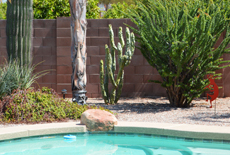
Brian and Colleen’s back yard with “totem pole” cactus – Beautiful!
Saw some interesting things- good and bad… Most homes have no lawn in the front yard, and large back yards typically have a limited amount of lawn. I think this is a good approach that saves water.
So what was used in place of lawn? It seems that at least 50% of the homes have swimming pools, and I saw some very well designed large outdoor patios and outdoor living spaces. For the landscaped areas, the ground cover of choice is small rock mulch (about 3/8″, angular rock).
Within the landscaped areas, I thought some of the plantings were a little thin. Creeping groundcovers, ornamental grasses, and massings of plants could be used more effectively to help cover the rock areas. Other features used in place of lawns were sport courts, outdoor kitchens, and shade structures.
Visiting the Desert Botanical Garden in Phoenix
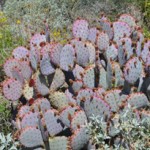
Purple Prickly Pear at the Desert Botanical Garden
This is truly an amazing garden! So many interesting cacti, agave, succulents, and native desert landscaping. They also were featuring some incredible glass sculptures by Dale Chihuly. I highly recommend visiting this garden if you are ever in the area! They have a great Facebook page as well, check it out.
Highway and Roadside Landscaping
One of the more striking features as you drive through Phoenix (and it is a very automobile dependent city) are the large swaths of roadside landscaping along the highways. Most of these areas are highly maintained slopes of rock with a few plants here and there.
My friends told me that there is a constant battle trying to eradicate the weeds from the rock- seems like a silly design solution to me. The nicer areas, in my opinion , had more plants grouped together in random, natural plantings. Other areas had formal planting in patterns and rows, or even just different color rock placed in patterns…

Aerials of Phoenix highway landscaping. Left- one of the nicer designs I saw, with random natural plantings. Right- this section had no plantings, with patterns of colored rock- not a fan of this approach.
Touring Local Nurseries
I had a chance to tour a local suburban Phoenix Nursery. I was interested to see what plants and materials were commercially available. I was happy you see that the trend of edible landscaping was equally as popular in Phoenix as it is in Denver, with a large selection of herbs, fruit trees, and other culinary delights.
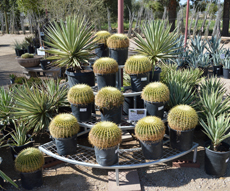
Agave, yucca, and cacti at a local suburban nursery
This nursery also had an impressive collection of sculpture and pottery- These items can add interest to a residential or commercial landscape, require little maintenance, and can serve as interesting focal points to the eye that break up large areas of rock.
One of the more interesting items for sale were packages of two Praying Mantis eggs- for natural pest control.
Hiking in the Superstition Wilderness
On my last day in the Phoenix area, my friend Brian and I went hiking in the Superstition Wilderness area. This turned out to be a very challenging hike to the top of the “flatiron” with amazing views and even more amazing native plants! I couldn’t help but think, – Why couldn’t some of those roadside highway areas be allowed to naturalize like some of this wild landscape, which received no maintenance and no irrigation?
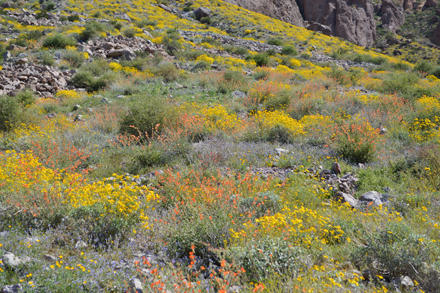
Native wildflowers- the orange flowers are Desert Mallow (Sphaeralcea ambigua), which grows great in my Denver garden!
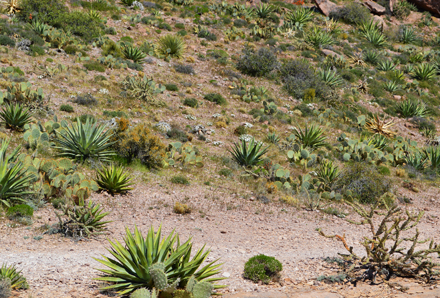
Native landscaping in the Superstition Wilderness area- Why can’t the highway roadside areas be naturalized like this?
This is the official blog of Outdoor Design Group, Colorado Landscape Architects. For more information about our business and our services, click here.
Related Posts:
by Matt Corrion

This is the official blog of Outdoor Design Group, Colorado Landscape Architects. For more information about our business and our services, click here.
Related Posts:
by Matt Corrion
The Colorado Front Range has some of the best fall weather to be had in the United States. When it comes to interesting fall foliage color however, Colorado lacks the abundance of color that can be found in other parts of the country. But with the right choice of trees you can enjoy some wonderful foliage fireworks in your own backyard.
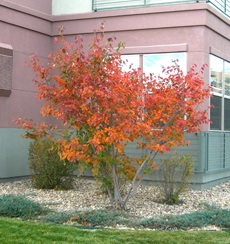 Serviceberry
Serviceberry
Serviceberries are beautiful tree-like shrubs. They offer great spring flowers, edible berries that attract birds and beautiful fall color. They are also good choices for water wise landscapes.
Autumn Brilliance Serviceberry – Amalanchier x grandiflora 12’ Ht x 10’ W
Shadblow Serviceberry – Amalanchier canadensis 12’ Ht x 10’ W
Crabbapple
The popular ornamental trees are renowned for their their spring flowers, but these crabapples provide excellent fall interest as well.
Indian Summer – Malus ‘Indian Summer’ Orange-red fall color. 18’ Ht x 18’ W
Lancelot – Malus ‘Lancelot’ Yellow-gold fall color. 10’ Ht x 8’ W
Prairiefire – Malus ‘Prairiefire’ Orange-red fall color. 20’ Ht x 20’ W
Spring Snow – Malus ‘Spring Snow’ Yellow fall color. 20’ Ht x 20’ W
Ash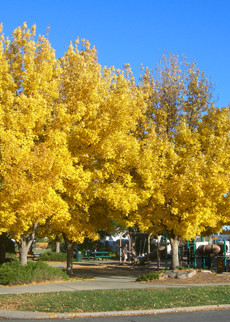
Autumn Purple – Fraxinus Americana As if it glows from within the center of the tree, this Ash is a sight to behold. The color is a mixture of gold to bronze-purple. 50’ Ht x 30’ W
Fall Gold – Fraxinus nigra The bright yellow gold of this tree is great against a crisp blue Colorado fall sky. 40’ Ht x 25’ W
Ornamental Pear
You can find these often planted along streets and in commercial landscapes. They provide spring flowers and fall color in relatively compact form.
Autumn Blaze – Pyrus calleryana ‘Autumn Blaze’ Orange red fall color. 30’ Ht x 25’ W
Chanticleer – Pyrus calleryana ‘Chanticleer’ Orange red fall color in an upright form. 35’ Ht x 15’ W
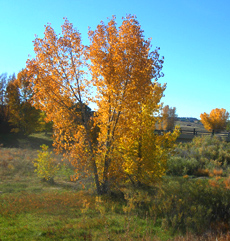 Cottonwood
Cottonwood
Just like their cousin the Aspen, Cottonwoods are known for their yellow gold leaves. Although they are not recommended for residential yards due to their size and tendency to sucker, they are wonderful in large areas with native planting schemes, especially in wetter areas like drainages and ravines.
Plains – Populus sargentii 60’ Ht x 50’ W
Narrowleaf – Populus angustifolia 75’ Ht x 40’ W
Lanceleaf – Populus acuminate 50’ Ht x 30’ W
Maple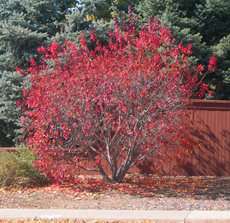
These maple trees will provide great red to orange-red color for your landscape. The Autumn Flame is gorgeous, but it can suffer chlorosis in our alkaline soils. Amur and Tatarian are the most fool-proof choices for our soils and climate.
Amur – Acer ginnala 20’ Ht x 10’ W
Bigtooth – Acer grandidentatum 25’ Ht x 25’ W
Autumn Blaze – Acer x fremanii ‘Autumn Blaze’ 50-40’ Ht x 30-40’ W
Tatarian Maple – Acer tataricum 25’ Ht x 20’ W
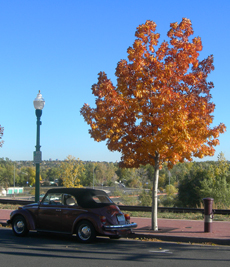 Oak
Oak
Several of the Oak species are wise choices for Colorado Front Range climate and soils. And a few of these offer nice fall foliage as well.
Chinkapin Oak – Quercus muehlenbergii Yellow fall color. 35-50’ Ht x 35-50’ W
English Oak – Quercus robur Golden yellow fall color. 40-60’ Ht x 30-40’ W
Northern Red Oak – Quercus rubra Bronze to wine red fall color. 40-60’ Ht x 40-60’ W
This is the official blog of Outdoor Design Group, Colorado Landscape Architects. For more information about our business and our services, click here.
Related Posts:
by Matt Corrion
The team of landscape architects at Outdoor Design Group, Inc. are thrilled to be partnering with Bud Surles Signature Resorts of Victor, Idaho to create a master plan for an exclusive new resort project in Tangshan Bay, China. The 285 acre park and resort on the Pacific coast will be one of the first of it’s kind to be completed in China, and will feature commercial space, lakes, trails, water features, marinas, and numerous active recreational amenities.
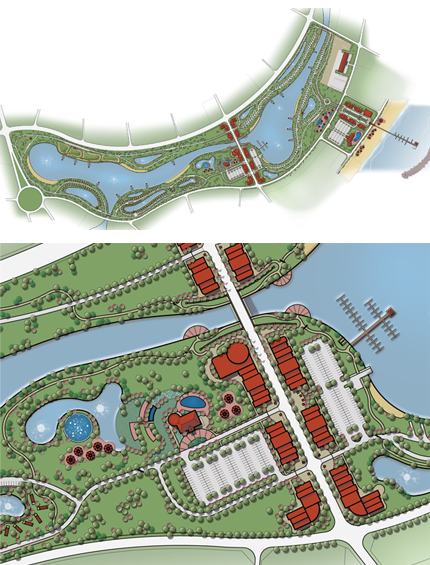
Outdoor Design Group, Inc. was founded in 2004 by Denver landscape architect Matt Corrion. The firm’s office is located in Olde Town Arvada, Colorado. Additional details about the Tangshan Bay Resort project will be shared as they become available. For more information please contact Outdoor Design Group at 303-993-4811.
This is the official blog of Outdoor Design Group, Colorado Landscape Architects. For more information about our business and our services, click here.
Related Posts:
by Matt Corrion
The drought of 2002 was very hard on landscaping in Colorado. Plants and lawns were stressed by the hot and dry conditions, and mandatory watering restrictions were put in place across the state. Many of us in the landscaping industry vividly remember these hard times.
Well, the drought is back. Today the USDA predicted a huge drop in corn yields, the latest is a long summer of bad drought news. Below are maps issued by the U.S. Drought Monitor from back in July of 2002 and from July of 2012. As you can see, there are many similarities and much of Colorado is once again in an “extreme drought” situation.
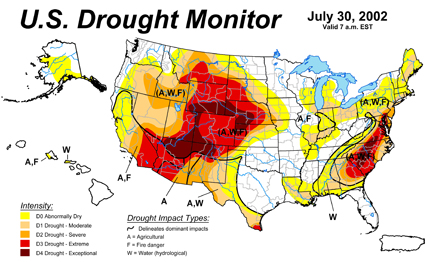
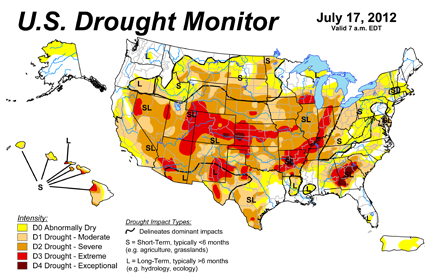
Outlook Does Not Look Good
According to the National Weather Service Climate Prediction Center, the U.S. Seasonal Drought Outlook doe not look promising, although some improvement may occur in southwestern Colorado:
Dryness and drought, exacerbated by above-normal temperatures, have been increasing both in extent and intensity across much of the central and northern U.S. Based upon the July 24 U.S. Drought Monitor, almost 64 percent of the contiguous U.S. was in drought (D1-D4), the highest such value for the U.S. Drought Monitor since its inception in 2000. The last time the lower 48 States had a comparable area of drought (based upon the monthly Palmer Drought Index) was in 1956, according to NCDC.
Across the Southwest, the odds favor an active (wet) southwest monsoon in both the 1- and 3-month precipitation outlooks. As a result, improvement is anticipated across much of Arizona, southern Utah, and southwestern Colorado as the summer monsoon continues.
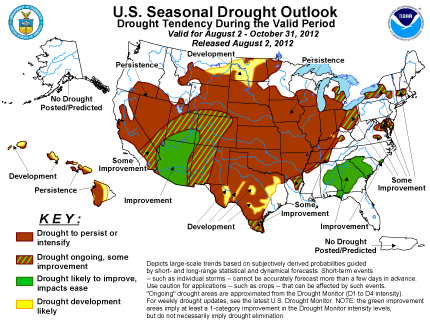
What Does this Mean for Landscaping in Colorado?
As these maps illustrate, the drought conditions that plagued Colorado in 2002 have resurfaced, and most long-term indicators point to continued drought. The good new is that there are some relatively simple changes and considerations for your landscaping to make it resilient to these conditions.
Some of the lessons we have learned and changes that can be made to your landscaping to better withstand drought include:
- Design new landscapes to be more drought tolerant in the first place. Take a more thoughtful professional approach to your landscape design and consider long term maintenance costs as well as installation costs. Consider hiring a landscape architect or design professional.
- Install the latest irrigation technologies to eliminate wasted water: smart weather based controllers, rain sensors, efficient spray nozzles and drip irrigation, to name a few.
- If lawn areas are not used for foot traffic, and are simply for aesthetics, convert these areas to masses of low growing shrubs, groundcovers, or native grass. You can achieve a similar look with plant massings at the groundplane while reducing water needs and maintenance requirements significantly.
- If you have an older irrigation system, consider having a professional do a water audit, and upgrade old nozzles to new, more efficient ones. If you are stuck with a landscape that requires a lot of water (such as large areas of bluegrass with spray irrigation) you should at least fine tune your sprinkler system. This approach is kind of like putting lipstick on a pig (since your landscape will still “require” the same amount of water to be healthy), however there are some new irrigation nozzles such as the Hunter MP Rotator that can be much more efficient at delivering water where it’s needed. At the very least, these upgrades could be a stopgap measure until the landscape can be renovated.
- Remove large areas of high water use bluegrass and lawns, and replace with native or drought tolerant plantings. A renovation of this sort will make the biggest impact by far. You can covert your landscaping from one that requires a lot of water to remain healthy, to one that requires minimal water and still looks beautiful.
So there you have it. The drought is here to stay. Colorado is a semi-arid climate that will remain dry. While tweaks and minor changes to irrigation systems can provide temporary relief, landscaping that requires a lot of water to stay healthy will always struggle in Colorado and the best approach is to install drought tolerant landscaping from the start, or renovate your landscaping to plantings that require less water.
This is the official blog of Outdoor Design Group, Colorado Landscape Architects. For more information about our business and our services, click here.
Related Posts:







 Serviceberry
Serviceberry
 Cottonwood
Cottonwood
 Oak
Oak


